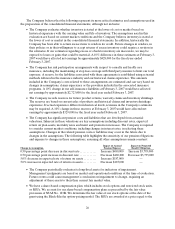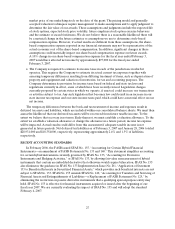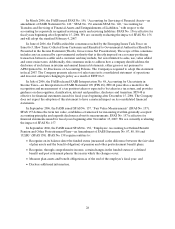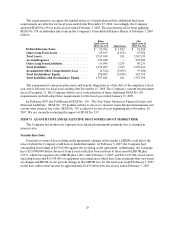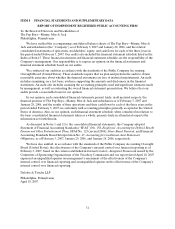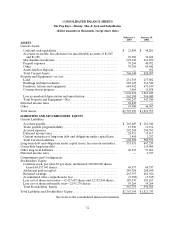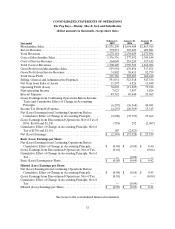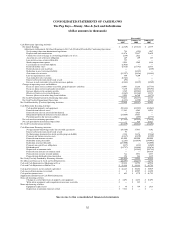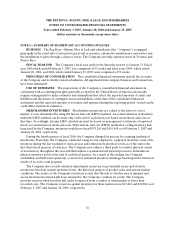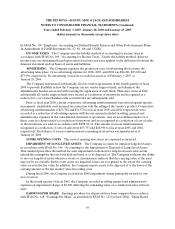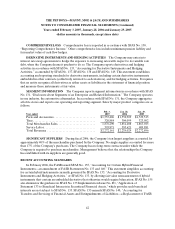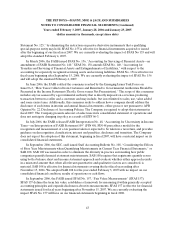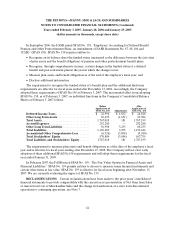Pep Boys 2006 Annual Report Download - page 75
Download and view the complete annual report
Please find page 75 of the 2006 Pep Boys annual report below. You can navigate through the pages in the report by either clicking on the pages listed below, or by using the keyword search tool below to find specific information within the annual report.THE PEP BOYS—MANNY, MOE & JACK AND SUBSIDIARIES
NOTES TO CONSOLIDATED FINANCIAL STATEMENTS
Years ended February 3, 2007, January 28, 2006 and January 29, 2005
(dollar amounts in thousands, except share data)
36
NOTE 1—SUMMARY OF SIGNIFICANT ACCOUNTING POLICIES
BUSINESS The Pep Boys—Manny, Moe & Jack and subsidiaries (the “Company”) is engaged
principally in the retail sale of automotive parts and accessories, automotive maintenance and service and
the installation of parts through a chain of stores. The Company currently operates stores in 36 states and
Puerto Rico.
FISCAL YEAR END The Company’s fiscal year ends on the Saturday nearest to January 31. Fiscal
year 2006 which ended February 3, 2007, was comprised of 53 weeks and fiscal years 2005, which ended
January 28, 2006, and 2004, which ended January 29, 2005, were comprised of 52 weeks.
PRINCIPLES OF CONSOLIDATION The consolidated financial statements include the accounts
of the Company and its wholly owned subsidiaries. All significant intercompany balances and transactions
have been eliminated.
USE OF ESTIMATES The preparation of the Company’s consolidated financial statements in
conformity with accounting principles generally accepted in the United States of America necessarily
requires management to make estimates and assumptions that affect the reported amounts of assets and
liabilities and disclosure of contingent assets and liabilities at the date of the consolidated financial
statements and the reported amounts of revenues and expenses during the reporting period. Actual results
could differ from those estimates.
MERCHANDISE INVENTORIES Merchandise inventories are valued at the lower of cost or
market. Cost is determined by using the last-in, first-out (LIFO) method. An actual valuation of inventory
under the LIFO method can be made only at the end of each fiscal year based on inventory and costs at
that time. Accordingly, interim LIFO calculations must be based on management’s estimates of expected
fiscal year-end inventory levels and costs. If the first-in, first-out (FIFO) method of costing inventory had
been used by the Company, inventory would have been $593,265 and $615,698 as of February 3, 2007 and
January 28, 2006, respectively.
During the fourth quarter of fiscal 2006, the Company changed its process for counting its physical
inventories. Previously, the Company conducted, using its own employees, a physical inventory count of its
inventory during the last weekend of its fiscal year and estimated its inventory levels as of the end of the
first three fiscal quarters of each year. The Company now utilizes a third party to conduct physical counts
of its inventory throughout the year and then utilizes a systemized roll-forward process to determine its
physical inventory levels at the end of each fiscal quarter. As a result of this change, the Company
established, and will revise quarterly, a reserve for estimated inventory shrinkage based upon the historical
results of its cycle count program.
The Company also records valuation adjustments (reserves) for potentially excess and obsolete
inventories based on current inventory levels, the historical analysis of product sales and current market
conditions. The nature of the Company’s inventory is such that the risk of obsolescence is minimal and
excess inventory has historically been returned to the Company’s vendors for credit. The Company
provides reserves when less than full credit is expected from a vendor or when market is lower than
recorded costs. The Company’s reserves against inventory for these matters were $13,462 and $12,822 as of
February 3, 2007 and January 28, 2006, respectively.


